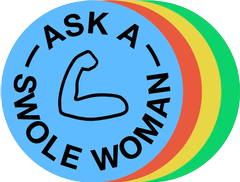Sick of clean eating, perfect gym outfits, and chiseled abs? A Swole Woman is here to help you be healthy, enjoy carbs, and get jacked.
Advertisement
Anyway—I’m not someone who normally needs or wants to have a lot of imagination or creativity about how to work out, and this is one of the things I love about heavy lifting. The foundational movements are easy to learn but hard to master, and I get a lot of joy of a) not having to learn skills anew or maintain a vast variety of them in order to feel like I’m doing a good workout, and b) just trying to do this very limited set of things I can hold in my brain more correctly than the last time I did them, because that’s all you need to do to make progress.Every once in a while I learn a new variation of some movement, but the basics (squat, bench, deadlift, row, overhead press) are an entire universe unto themselves. There’s no need to work out each muscle individually for three sets of 20, or to use 12 different movements on your arms to make them “toned.”All that said, when I am not actually able to focus on these basic movements and slowly make them heavier, for a total lack of the equipment I need to do them, I’m definitely getting bored. Doing isolateral (one side of the body at a time) movements for sets of 12-15 even for only a few movements means I’m doing hundreds of reps; I could cry tears, it can get so tedious. I’ve even gotten back into listening to music and podcasts, which I can’t normally pay attention to during my gym sessions.But I’ve also had some luck with “simply trying new, non-rep-and-set-focused skills,” where I Iet myself just try to do a new thing for a while. I made it my vague goal to get better at handstands and pistol squats while isolated.
Advertisement
And while I haven’t made substantial progress at either, I try to keep in mind that I can learn a lot by trying to do something I’m terrible at (and it hurts no one but me to do so). I also try to remember that the burden of benefiting from trying to do something is not “learning to actually successfully do it”; embracing the process of learning and progression is a core fitness goal in and of itself. If I come out of this 10 percent better at pistol squats, I’ll have at least learned… something.Most hard movements have “progressions,” or a series of variations that build your skills to do the ultimate really hard version, that are plenty of work on their own. Maybe you’ll never learn to do the hard thing! There are a number of things in here that, I’ll say outright, I’m never going to be able to do, mostly from a lack of will. But trying to work my way toward them can still be fun and, most importantly, distracting from the total lack of control we all feel right now.Usually the progress framework of heavy lifting (adding more weight, focusing on different cues to do it better each time) keeps me occupied, but when that’s gone, variety can be the answer. I find a lot of bodyweight exercises to be overly mythologized and harder than they look, and that's a lot of what's in here. But if you manage your expectations, especially when we literally can't go to gyms, there's something to get out of them.
Advertisement
This goes for pull-ups, or pushups, or any of the stuff I’m going to list here. Not all of this is strength stuff, and there are a few things at the end that kinda anyone can try to do and could benefit from. I included more ideas that any reasonable person can pursue at once because some of them will be dependent on the equipment you have, but your idea of what is a “weight” should be a very fluid concept right now. The cat, some books, a gallon jug of water, a suitcase filled with rocks can all be weights. Tables, chairs, and boxes can be tools. This can be an annoying part to figure out, but once you have your setup the sailing will be much smoother. (Just be careful with all this, it's not a great time to go to the hospital.)This is harder than it looks and has super-functional applications; who among us doesn't have to stand up from lying down? This blog claims it has “neurological benefits”, which, uh, sure, but it’s a decent conditioning workout and helps develop stabilizing muscles, one of the things I love about lifting in general. To get better at this, you can do more reps or try to increase the weight you use. (And start with no weight at all, so if you ever add any weight, instant progress!)
Do you have a question about working out, eating, health, or why you shouldn't be afraid of lifting heavy weights? Send it to swole.woman@vice.com and follow @swolewoman on Instagram.
Turkish getup
Advertisement
Yoke/farmer/suitcase carries
Overhead carries
Overhead squats
Advertisement
Pistol squat
Handstands
Advertisement
All that said: I think handstands are pretty cool. We don’t do a lot of overhead-strength things in real life, so making special time for it makes sense. I personally harbor a secret aspiration to learn to do a press to handstand, where you start from standing, bend over and put your hands on the ground with legs straight, and sweep your legs up and over your head. It looks so hard, and it rules, and there are lots of practice movements to try out.This is another strongman-type movement that I think is disproportionately cool. It just looks fun. It depends on having a manageable weight that won’t break your wrist off—no suitcases, probably—but it’s something I could see myself doing until my shoulder fell off. You can also do this movement with two weights (ideally kettlebells or dumbbells), and you can also do it for reps, lowering the weights to the ground between reps.Hey if we’re talking about pushups, you don’t have to stop at just trying to do a million normal ones. There are a bunch of absolutely messed-up ones you can try to do too.I never knew this was what this was called, but I sure did it a lot on the playground as a kid, and it kills me to think about what flexible shoulders I must have had. Mobility queen. Nonetheless, it requires “Olympic rings” which seem like they wouldn’t be too hard to acquire or set up in a home gym, and might be available at a playground with one of those “fitness areas” for adults.
Single-arm clean and press (“circus dumbbell press”)
One arm pushups or clapping pushups
A "skin the cat"
Advertisement
Iron cross
Planche
Full body “scan” or “relaxation”
Advertisement

